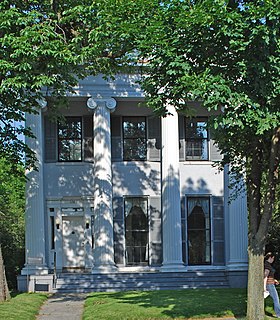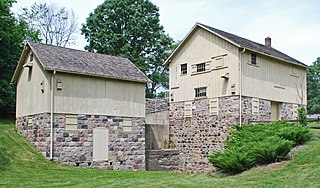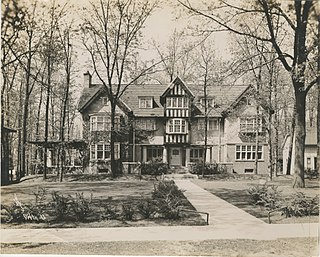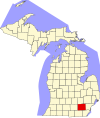
Washtenaw County is a county located in the U.S. state of Michigan. As of the 2020 census, the population was 372,258. The county seat is Ann Arbor. The county was authorized by legislation in 1822, and was organized as a county in 1826. Washtenaw County comprises the Ann Arbor Metropolitan Statistical Area and is included in the Detroit-Warren-Ann Arbor Combined Statistical Area. The county is home to the University of Michigan, Eastern Michigan University, Washtenaw Community College, and Concordia University Ann Arbor.

In Ann Arbor, Michigan, Stefan T. Vail Cooperative House is a housing cooperative for college students at the University of Michigan, Washtenaw Community College, and Eastern Michigan University. A member of the Inter-Cooperative Council (ICC) in Ann Arbor, Vail house is named after Stefan Valavanis, a former ICC President who became a notable economist. It is one of only two known adobe buildings in Ann Arbor.
Alden B. Dow was an American architect based in Midland, Michigan, and known for his contributions to the style of Michigan Modern. During a career that spanned from the 1930s to the 1960s, he designed more than 70 residences and dozens of churches, schools, civic and art centers, and commercial buildings. His personal residence, the Midland Center for the Arts, and the 1950s Grace A. Dow Memorial Library are among numerous examples of his work located in his hometown of Midland, Michigan. The son of Herbert Henry Dow and philanthropist Grace A. Dow, Dow is known for his prolific architectural designs.
Spier, Rohns & Gehrke was a noted Detroit, Michigan architectural firm operated by Frederick H. Spier and William C. Rohns, best remembered for designs of churches and railroad stations. These were frequently executed in the Richardson Romanesque style. F.H. Spier, W.C. Rohns and Hans Gehrke were authors of the Detroit Chamber of Commerce, tallest building in the city at the time of construction (1895). Hans Gehrke's well known structures include the Fire Department Headquarters on Larned Street in Detroit, and residence of Robert C. Traub in Arden Park residential district of Detroit.

The Cobblestone Farm and Museum, which includes the Dr. Benajah Ticknor House is an historical museum located at 2781 Packard Road in Ann Arbor Michigan. The museum gets its name from the cobblestone used to build the farmhouse. It was listed on the National Register of Historic Places in 1972 and designated a Michigan State Historic Site in 1973.
Ralph Stephens Gerganoff, born Rashko Stoyanov Gerganov, also frequently referred to as R.S. Gerganoff was an American architect.

The Unitarian Universalist Church is a historic church building at 100 N. State Street in Ann Arbor, Michigan. It was listed on the National Register of Historic Places in 1978.

The Bell Road Bridge is a Pratt through truss bridge in Dexter Township, Washtenaw County, Michigan. Built in 1891, the bridge carried Bell Road over the Huron River. Since 1997, the bridge has sat on the riverbank, overgrown with brush. The bridge is a Michigan State Historic Site and is listed on the National Register of Historic Places.

The Delhi Bridge, also known as the East Delhi Bridge, is a one-lane, wrought iron Pratt through truss bridge that carries East Delhi Road over the Huron River in Washtenaw County, Michigan. The bridge was completed October 12, 1883 to replace a wooden span built in 1851. In 1917, the bridge was severely damaged by a tornado but was rebuilt. After it was closed to traffic in 2005 for being unsafe, the bridge was renovated and reopened in 2009. The bridge is listed on the National Register of Historic Places.

Gordon Hall, also known as the Judge Samuel W. Dexter House, is a private house located at 8341 Island Lake Road in Dexter, Michigan. It was designated a Michigan State Historic Site in 1958 and listed on the National Register of Historic Places in 1972. The house is unique in Michigan for its balance, large scale, and massive hexastyle portico. The structure is also significant as the dwelling of Judge Samuel W. Dexter, a pioneering Michigan resident and land baron who had a substantial impact on early development of Washtenaw County and other sections of the state. The house was later owned by Dexter's granddaughter Katharine Dexter McCormick, a pioneering research scientist, suffragist, and philanthropist. In its early days, Gordon Hall hosted at least two, and possibly three United States presidents, and it was almost certainly a stop along the Underground Railroad.

The Judge Robert S. Wilson House, also known as the Wilson-Wahr House, is a private house located at 126 North Division Street in Ann Arbor, Michigan. It was listed on the National Register of Historic Places in 1972.

The Tuomy Hills Service Station is a commercial building located 2460 Washtenaw Avenue in Ann Arbor, Michigan. It was listed on the National Register of Historic Places in 2000.

The Parker Mill, also known as Parker Mill Park or Parker Mill Complex, is a mill located at 4650 Geddes Road, east of Ann Arbor, Michigan. The mill is a well-preserved example of a small-scale grist mill operation that was once common in Michigan. The mill and nearby Parker House were listed on the National Register of Historic Places in 1982.

St. Thomas the Apostle Catholic Church is a parish of the Roman Catholic Church located in Ann Arbor, Michigan at 530-540 Elizabeth Street. Its historic parish church is listed as a Michigan State Historic Site.

The Henry S. Frieze House is a single family house located at 1547 Washtenaw Avenue in Ann Arbor, Michigan, United States. It was listed on the National Register of Historic Places in 1972.

The Bell-Spalding House, also known as the Tuomy House, is a single-family home located at 2117 Washtenaw Avenue in Ann Arbor, Michigan. It was listed on the National Register of Historic Places in 1990.

The Thomas Earl House was built as a single-family home located at 415 North Main Street in Ann Arbor, Michigan. It was listed on the National Register of Historic Places in 1992. The house has been renovated to office space.

The Kellogg-Warden House is a single-family house located at 500 North Main Street in Ann Arbor, Michigan. It was listed on the National Register of Historic Places in 1994. It now houses the Washtenaw County Historical Society's Museum on Main Street.

The Delta Upsilon Fraternity House is a fraternity house located at 1331 Hill Street in Ann Arbor, Michigan. It was listed on the National Register of Historic Places in 1995.





















